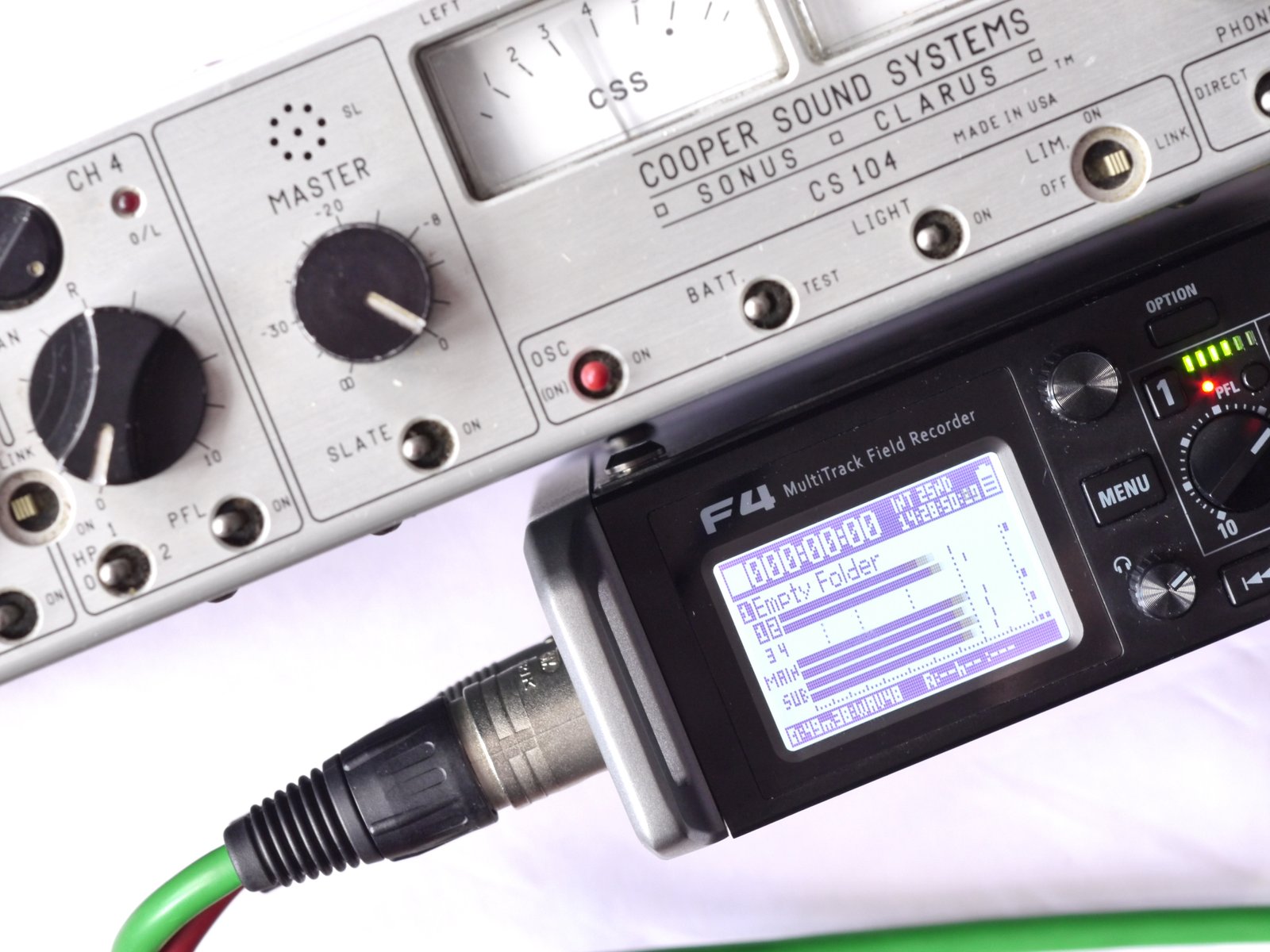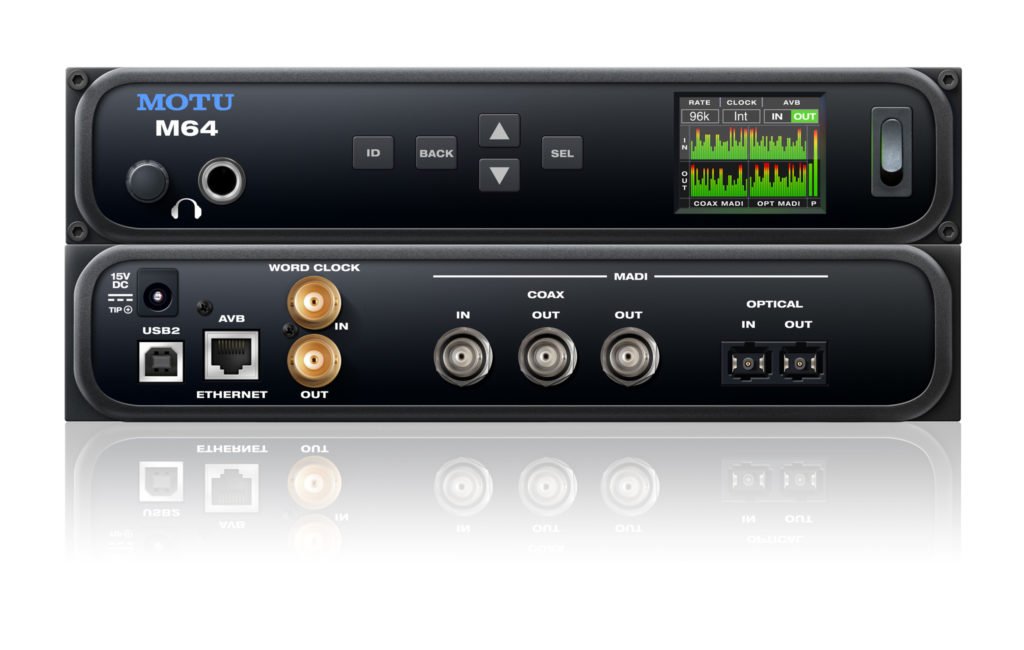In these trying times of austerity value for money has become not just important but almost all important in our purchasing decisions. So how might we judge two of the latest offerings from MOTU – the 624 and the M64 – against the vfm yardstick? I suggest that there are two main factors in our choice of computer audio interfaces – the basic I/O count – and what you might call the extras – all the other goodies.
Two of MOTUs latest designs the 624 and the M64 come in the standard MOTU half rack package and each has a high resolution colour screen mostly given over to metering but also showing clocking and sample rate info and with access to device information and some control functions. The 624 has pots for the front panel guitar inputs and also for the two mic inputs which also have separate hardware controls for the pad and phantom power. The M64 has no audio controls beyond the headphone pot but there is full control via the web interface. And both devices can recall factory and user presets from the front panel.
The new MOTU 624 offers 8 analogue inputs, two mics, two Hi Z for guitars etc and four balanced/unbalanced line inputs. You also get eight digital inputs on ADAT, four at high sample rates. Outputs offered are six balanced/unbalanced analogue line, plus a stereo headphone feed and eight outputs on ADAT.
That’s a tidy amount of I/O but I think it is the other half of the proposition that really strengthens the 624’s hand and the big players here are DSP and AVB, now often seen as AVB-TSN – time sensitive networking.
The plus for an AVB-TSN equipped device like the 624 is that down one ethernet cable is you get lots of channels, 512 in a MOTU network (at 1x sample rate) and 64 channels of low latency audio in and out of a 624. This is significant protection of your investment. I appreciate two mics and two guitars though I would rather have four mic preamps from the get go – but if one day I really need more mic inputs, or indeed more of just about any sort of input, then I pop down the MOTU shop and take my pick of the appropriate AVB-TSN interfaces. The MOTU AVB-TSN range now offers everything from a fully rigged 16 in 8 out stage box, via all manner of analogue and digital options through to the M64, which offers 128 channels of MADI input.
Up till the arrival of AVB-TSN the classic way expand your channel count has been ADAT or MADI – but look at the AVB-TSN advantages. AVB-TSN offers huge channel expansion possibility, runs on standard ethernet cables up to 100m and is fully network capable. Build yourself an AVB-TSN network and you can aggregate multiple devices routing audio in and out of the network at will. To build a proper network you will need a switch – probably MOTUs AVB-TSN switch, remember you can’t use an ordinary ethernet switch – it has to speak AVB! And once your other MOTU AVB-TSN units are connected you have full control over them from a web based app – which can run anywhere on the network into which the interface is connected or over the USB/Thunderbolt connection to the computer. Control the network from a wireless device with a browser. However if you have just two devices then you don’t need the switch just cat5 them together.
The other big boost for MOTU’s interfaces is the mixing power. Each AVB-TSN interface carries enough DSP to mix and process 48 channels of audio and given you have up to 64 extra inputs this mixer is real world relevant. It includes some sweet eq and gates and compressors on every channel. There’s even a basic reverb for your monitor mix.
I began by plugging some channels of MADI mic preamp into the M64, I then piped that over AVB-TSN into the 624 which in turn was connected by usb (or Thunderbolt) to my Macbook Air or a Windows 10 machine. If I had enough sources, I could now take my pick from up to 128 MADI channels from the M64, one over coax and the other over optical plus the sixteen inputs of the 624. MOTU specs the 624 with USB 3 and Thunderbolt on board as delivering 128 channels at 44/48 and up to 64 channels all the way up to 192Khz.
The M64 is a digital only device but MOTU have worked hard on the 624’s analogue audio, it features the Sabre32 DAC which is the same as used in it’s bigger brother, the 1248, and offers the same increased signal to noise on the analogue outputs. I tried the 624 mic amps against some big ticket alternatives and found the MOTU preamps easily holding their own.
Put AVB-TSN and MADI you get some serious reach. For instance the 624 is connected to the computer by a 2m Thunderbolt lead but the M64 can be up to 100m away down the Cat5 and the MADI kit can be another 100m away – add a switch and we have another 100m of cable. This is massive flexibility and allows ambitious deployment way beyond the standard duties of sound cards – how do I get my SM58 and trusty Fender into my laptop and hear the results.
Control of your MOTU is down to a web based app that discovers your device or devices, integrates their connected AVB-TSN I/O and presents it to you in a browser window for routing and mixing. The down side? Well the massive flexibilty means you need be on your toes in terms of set up. Remember with AVB-TSN on board you have potentially 78 inputs and outputs on your 624 and that’s a big matrix. And then there’s the 48 channel mixer to think about. Fortunately MOTU have included lots of ways of simplyfing what you see and the signal present metering in the routing app is a big help. And for the M64 you are going to need it!
With 128 MADI inputs routable to 128 MADI outputs plus the 64 chanels of AVB-TSN the M64 is a great way to get MADI into your computer, I do wish it had gone USB3 for more channels to the computer. Having optical and coax inputs on board and optical output plux mirrored coax outputs means that the M64 is a powerful MADI problem solver. And out of the box the AVB-TSN devices come with factory presets to help you start solving a variety of problems. The 624 opens the door to AVB-TSN world gets you a seat at MOTU’s top audio quality table at a more affordable price than has been possible up to now. The 624 and M64 build on MOTU’s AVB-TSN series which offers features and power which are unique at their their price points. And that I suppose is a good definition of value for money.


